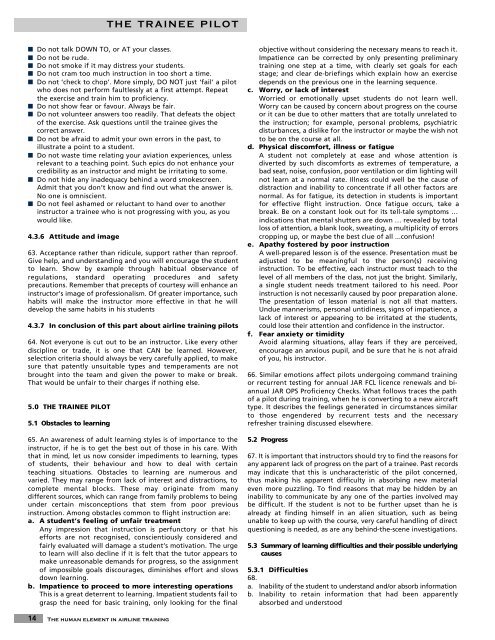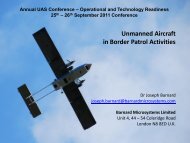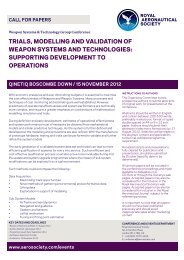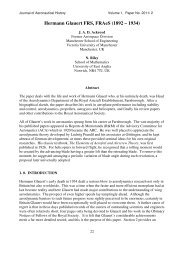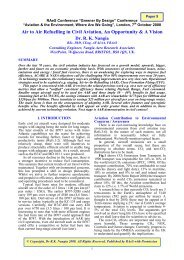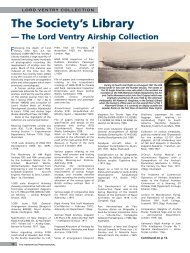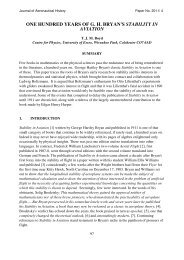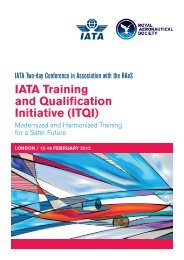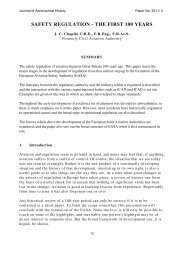The human element in airline training - Royal Aeronautical Society
The human element in airline training - Royal Aeronautical Society
The human element in airline training - Royal Aeronautical Society
Create successful ePaper yourself
Turn your PDF publications into a flip-book with our unique Google optimized e-Paper software.
14<br />
THE TRAINEE PILOT<br />
■ Do not talk DOWN TO, or AT your classes.<br />
■ Do not be rude.<br />
■ Do not smoke if it may distress your students.<br />
■ Do not cram too much <strong>in</strong>struction <strong>in</strong> too short a time.<br />
■ Do not ‘check to chop’. More simply, DO NOT just ‘fail’ a pilot<br />
who does not perform faultlessly at a first attempt. Repeat<br />
the exercise and tra<strong>in</strong> him to proficiency.<br />
■ Do not show fear or favour. Always be fair.<br />
■ Do not volunteer answers too readily. That defeats the object<br />
of the exercise. Ask questions until the tra<strong>in</strong>ee gives the<br />
correct answer.<br />
■ Do not be afraid to admit your own errors <strong>in</strong> the past, to<br />
illustrate a po<strong>in</strong>t to a student.<br />
■ Do not waste time relat<strong>in</strong>g your aviation experiences, unless<br />
relevant to a teach<strong>in</strong>g po<strong>in</strong>t. Such epics do not enhance your<br />
credibility as an <strong>in</strong>structor and might be irritat<strong>in</strong>g to some.<br />
■ Do not hide any <strong>in</strong>adequacy beh<strong>in</strong>d a word smokescreen.<br />
Admit that you don’t know and f<strong>in</strong>d out what the answer is.<br />
No one is omniscient.<br />
■ Do not feel ashamed or reluctant to hand over to another<br />
<strong>in</strong>structor a tra<strong>in</strong>ee who is not progress<strong>in</strong>g with you, as you<br />
would like.<br />
4.3.6 Attitude and image<br />
63. Acceptance rather than ridicule, support rather than reproof.<br />
Give help, and understand<strong>in</strong>g and you will encourage the student<br />
to learn. Show by example through habitual observance of<br />
regulations, standard operat<strong>in</strong>g procedures and safety<br />
precautions. Remember that precepts of courtesy will enhance an<br />
<strong>in</strong>structor’s image of professionalism. Of greater importance, such<br />
habits will make the <strong>in</strong>structor more effective <strong>in</strong> that he will<br />
develop the same habits <strong>in</strong> his students<br />
4.3.7 In conclusion of this part about airl<strong>in</strong>e tra<strong>in</strong><strong>in</strong>g pilots<br />
64. Not everyone is cut out to be an <strong>in</strong>structor. Like every other<br />
discipl<strong>in</strong>e or trade, it is one that CAN be learned. However,<br />
selection criteria should always be very carefully applied, to make<br />
sure that patently unsuitable types and temperaments are not<br />
brought <strong>in</strong>to the team and given the power to make or break.<br />
That would be unfair to their charges if noth<strong>in</strong>g else.<br />
5.0 THE TRAINEE PILOT<br />
5.1 Obstacles to learn<strong>in</strong>g<br />
65. An awareness of adult learn<strong>in</strong>g styles is of importance to the<br />
<strong>in</strong>structor, if he is to get the best out of those <strong>in</strong> his care. With<br />
that <strong>in</strong> m<strong>in</strong>d, let us now consider impediments to learn<strong>in</strong>g, types<br />
of students, their behaviour and how to deal with certa<strong>in</strong><br />
teach<strong>in</strong>g situations. Obstacles to learn<strong>in</strong>g are numerous and<br />
varied. <strong>The</strong>y may range from lack of <strong>in</strong>terest and distractions, to<br />
complete mental blocks. <strong>The</strong>se may orig<strong>in</strong>ate from many<br />
different sources, which can range from family problems to be<strong>in</strong>g<br />
under certa<strong>in</strong> misconceptions that stem from poor previous<br />
<strong>in</strong>struction. Among obstacles common to flight <strong>in</strong>struction are:<br />
a. A student’s feel<strong>in</strong>g of unfair treatment<br />
Any impression that <strong>in</strong>struction is perfunctory or that his<br />
efforts are not recognised, conscientiously considered and<br />
fairly evaluated will damage a student’s motivation. <strong>The</strong> urge<br />
to learn will also decl<strong>in</strong>e if it is felt that the tutor appears to<br />
make unreasonable demands for progress, so the assignment<br />
of impossible goals discourages, dim<strong>in</strong>ishes effort and slows<br />
down learn<strong>in</strong>g.<br />
b. Impatience to proceed to more <strong>in</strong>terest<strong>in</strong>g operations<br />
This is a great deterrent to learn<strong>in</strong>g. Impatient students fail to<br />
grasp the need for basic tra<strong>in</strong><strong>in</strong>g, only look<strong>in</strong>g for the f<strong>in</strong>al<br />
<strong>The</strong> <strong>human</strong> <strong>element</strong> <strong>in</strong> airl<strong>in</strong>e tra<strong>in</strong><strong>in</strong>g<br />
objective without consider<strong>in</strong>g the necessary means to reach it.<br />
Impatience can be corrected by only present<strong>in</strong>g prelim<strong>in</strong>ary<br />
tra<strong>in</strong><strong>in</strong>g one step at a time, with clearly set goals for each<br />
stage; and clear de-brief<strong>in</strong>gs which expla<strong>in</strong> how an exercise<br />
depends on the previous one <strong>in</strong> the learn<strong>in</strong>g sequence.<br />
c. Worry, or lack of <strong>in</strong>terest<br />
Worried or emotionally upset students do not learn well.<br />
Worry can be caused by concern about progress on the course<br />
or it can be due to other matters that are totally unrelated to<br />
the <strong>in</strong>struction; for example, personal problems, psychiatric<br />
disturbances, a dislike for the <strong>in</strong>structor or maybe the wish not<br />
to be on the course at all.<br />
d. Physical discomfort, illness or fatigue<br />
A student not completely at ease and whose attention is<br />
diverted by such discomforts as extremes of temperature, a<br />
bad seat, noise, confusion, poor ventilation or dim light<strong>in</strong>g will<br />
not learn at a normal rate. Illness could well be the cause of<br />
distraction and <strong>in</strong>ability to concentrate if all other factors are<br />
normal. As for fatigue, its detection <strong>in</strong> students is important<br />
for effective flight <strong>in</strong>struction. Once fatigue occurs, take a<br />
break. Be on a constant look out for its tell-tale symptoms …<br />
<strong>in</strong>dications that mental shutters are down … revealed by total<br />
loss of attention, a blank look, sweat<strong>in</strong>g, a multiplicity of errors<br />
cropp<strong>in</strong>g up, or maybe the best clue of all ...confusion!<br />
e. Apathy fostered by poor <strong>in</strong>struction<br />
A well-prepared lesson is of the essence. Presentation must be<br />
adjusted to be mean<strong>in</strong>gful to the person(s) receiv<strong>in</strong>g<br />
<strong>in</strong>struction. To be effective, each <strong>in</strong>structor must teach to the<br />
level of all members of the class, not just the bright. Similarly,<br />
a s<strong>in</strong>gle student needs treatment tailored to his need. Poor<br />
<strong>in</strong>struction is not necessarily caused by poor preparation alone.<br />
<strong>The</strong> presentation of lesson material is not all that matters.<br />
Undue mannerisms, personal untid<strong>in</strong>ess, signs of impatience, a<br />
lack of <strong>in</strong>terest or appear<strong>in</strong>g to be irritated at the students,<br />
could lose their attention and confidence <strong>in</strong> the <strong>in</strong>structor.<br />
f. Fear anxiety or timidity<br />
Avoid alarm<strong>in</strong>g situations, allay fears if they are perceived,<br />
encourage an anxious pupil, and be sure that he is not afraid<br />
of you, his <strong>in</strong>structor.<br />
66. Similar emotions affect pilots undergo<strong>in</strong>g command tra<strong>in</strong><strong>in</strong>g<br />
or recurrent test<strong>in</strong>g for annual JAR FCL licence renewals and biannual<br />
JAR OPS Proficiency Checks. What follows traces the path<br />
of a pilot dur<strong>in</strong>g tra<strong>in</strong><strong>in</strong>g, when he is convert<strong>in</strong>g to a new aircraft<br />
type. It describes the feel<strong>in</strong>gs generated <strong>in</strong> circumstances similar<br />
to those engendered by recurrent tests and the necessary<br />
refresher tra<strong>in</strong><strong>in</strong>g discussed elsewhere.<br />
5.2 Progress<br />
67. It is important that <strong>in</strong>structors should try to f<strong>in</strong>d the reasons for<br />
any apparent lack of progress on the part of a tra<strong>in</strong>ee. Past records<br />
may <strong>in</strong>dicate that this is uncharacteristic of the pilot concerned,<br />
thus mak<strong>in</strong>g his apparent difficulty <strong>in</strong> absorb<strong>in</strong>g new material<br />
even more puzzl<strong>in</strong>g. To f<strong>in</strong>d reasons that may be hidden by an<br />
<strong>in</strong>ability to communicate by any one of the parties <strong>in</strong>volved may<br />
be difficult. If the student is not to be further upset than he is<br />
already at f<strong>in</strong>d<strong>in</strong>g himself <strong>in</strong> an alien situation, such as be<strong>in</strong>g<br />
unable to keep up with the course, very careful handl<strong>in</strong>g of direct<br />
question<strong>in</strong>g is needed, as are any beh<strong>in</strong>d-the-scene <strong>in</strong>vestigations.<br />
5.3 Summary of learn<strong>in</strong>g difficulties and their possible underly<strong>in</strong>g<br />
causes<br />
5.3.1 Difficulties<br />
68.<br />
a. Inability of the student to understand and/or absorb <strong>in</strong>formation<br />
b. Inability to reta<strong>in</strong> <strong>in</strong>formation that had been apparently<br />
absorbed and understood


